Acceptability of Children Road Safety Education in Pakistan: A Mixed-Method Approach to Exploring Parents’ and Teachers’ Perspectives
Abstract
1. Introduction
1.1. Parental and Teacher Involvement in RSE
1.2. The State of RSE in Pakistan
1.3. Research Objective
- To evaluate the current level of RSE programs for children among parents and teachers of primary, secondary, and high school children in Pakistan.
- To identify the factors influencing the acceptance and support of RSE among parents and teachers, including demographic and socio-economic variables.
- To explore the perceptions of parents and teachers towards the importance and implementation of RSE in the school curriculum.
2. Materials and Methods
2.1. Development of Questionnaire
2.1.1. Parents Involvement Questionnaire
2.1.2. Teachers Involvement Questionnaire
2.2. Development of Interviews
2.3. Sampling
2.3.1. Quantitative Data (Questionnaire)
2.3.2. Qualitative Data (Interviews)
2.4. Data Collection
2.5. Data Analysis
3. Results
3.1. Teachers Questionnaire Data
3.1.1. Demographic Characteristics of Teachers About RSE for Children
3.1.2. Effective Teaching Methods for Delivering RSE
3.1.3. Teachers Perception of Giving Road Safety Feedback to Parents
3.1.4. Teachers’ Opinions on Enhancing Road Safety for Children at School
3.1.5. Teachers Opinions in Enhancing Road Safety for Children in the Community
3.1.6. Effectiveness Level of Current RSE Programs
3.2. Teachers Interview Data
3.2.1. Challenges and Support Needs
“I have not followed any professional and teacher training program regarding traffic safety. The main reason is the society and school does not encourage it even there is not appropriate initiative from governments side as well.”
“a significant challenge is ensuring consistent engagement, as parents’ busy schedules can make it difficult for them to participate regularly.”
3.2.2. Curriculum Integration and Content
“Makes learning more engaging and relatable to real-world experiences” and “Reinforces road safety concepts from multiple angles.”
“The content will cover essential topics such as understanding traffic signals, pedestrian safety, the importance of wearing helmets and seat belts, and the dangers of distracted driving.”
3.2.3. Parental and Community Involvement
“I would recommend making participation mandatory, as traffic safety is a critical issue.”
“Offering flexible options, such as evening sessions or online resources, can help mitigate this issue.”
3.2.4. Program Design and Structure
“One successful strategy I have observed is involving parents in interactive workshops where they can learn alongside their children.”
“Encouraging children to practice what they learn at school in real-life situations helps reinforce their understanding and makes safety habits second nature.”
“Resources such as interactive digital content, real-life case studies, and simulation tools can make lessons more engaging and impactful.”
3.2.5. Teaching Method and Engagement Strategies
“In-person sessions can provide hands-on demonstrations and foster a sense of community among parents, making the learning experience more impactful.”
“Preferably a combination of physical and online sessions (recordings available for future reference).”
“The program was offered in a hybrid format, with initial theoretical lessons conducted online and practical workshops held physically.”
3.2.6. Training and Professional Development
“Offering continuous professional development opportunities throughout the year would also keep teachers updated on the latest traffic safety protocols and teaching methodologies.”
“Gaining knowledge and understanding of rules and situations” and “Developing and improving skills through training and experience.”
“Schools and educational institutions can support teachers by providing dedicated time for professional development on road safety.”
3.3. Parents Questionnaire Data
3.3.1. Demographic Data
3.3.2. Road Safety Knowledge
3.3.3. Transportation Habits
3.3.4. Awareness and Concerns
3.3.5. School and Community Involvement
3.3.6. Personal Experiences
3.3.7. Relation Between Parental Discussions on Road Safety and Parental Confidence in Child’s Understanding
3.3.8. Relation Between the Number of Children on Parental Confidence in Children’s Road Safety Knowledge
3.4. Parents Interview Data
3.4.1. Barriers to Participation and Cycling
“Good quality bikes and properly fitted helmets can be expensive, which might be a barrier for some families.”
“there is no cycling culture.”
“cycling might seem risky due to traffic or lack of safe cycling paths.”
3.4.2. Community and Stakeholder Involvement
“Hold regular meetings where parents can discuss road safety concerns and ideas for improvement in the neighborhood.”
“interactive initiatives like safety workshops at local parks or safety demonstrations with local authorities would be valuable.”
“Schools and communities play crucial roles in our child’s road safety education.”
3.4.3. Educational Content and Methods
“Hold regular meetings where parents can discuss road safety concerns and ideas for improvement in the neighborhood.”
“interactive initiatives like safety workshops at local parks or safety demonstrations with local authorities would be valuable.”
“Schools and communities play crucial roles in our child’s road safety education.”
3.4.4. Engagement and Communication
“Acknowledge schools and communities doing a great job with road safety education. This will inspire others!”
“City authorities could help by promoting cycling culture through different incentives and initiatives and improving the bicycling infrastructure.”
3.4.5. Safety and Infrastructure
“Improvements could include better training for teachers, more engaging materials, and active involvement of traffic police in educational activities.”
“improvements in road infrastructure and awareness campaigns could enhance safety.”
4. Discussion
4.1. Teachers Data
4.2. Parents Data
4.3. Limitations and Recommendations
5. Conclusions
Author Contributions
Funding
Institutional Review Board Statement
Informed Consent Statement
Data Availability Statement
Acknowledgments
Conflicts of Interest
Appendix A
| Themes | Codes | Description | Quotes |
|---|---|---|---|
| Challenges and Support Needs | Access to Up-to-Date Resources, Accessibility and Flexibility, Challenge of Consistent Engagement, Changing Attitudes and Motivations, Collaboration Among Teachers, Lack of Encouragement for Training Programs, Prioritizing Road Safety, Teacher Responsibility | Teachers face obstacles such as resource access, engagement consistency, and motivational shifts, requiring support for collaboration and prioritization. | “Ensuring consistent reinforcement at home and overcoming parents’ busy schedules.” “…ensuring consistent engagement, as parents’ busy schedules can make it difficult for them to participate regularly.” “Online sessions can be recorded and shared for those who cannot attend live, ensuring wider reach and flexibility.” “I have not followed any professional and teacher training program regarding traffic safety. The main reason is the society and school does not encourage it even there is not appropriate initiative from governments side as well.” “a significant challenge is ensuring consistent engagement, as parents’ busy schedules can make it difficult for them to participate regularly.” |
| Curriculum Integration and Content | Benefits of Integration, Combination of Theoretical and Practical Knowledge, Comprehensive Training Content, Curriculum Integration, Curriculum Integration of Road Safety Education, Essential Topics for Road Safety, Examples of Integration, Existing Training Program, Integration with Other Subjects | Effective road safety education requires integrating theoretical and practical knowledge within the curriculum, highlighting essential topics. | “Math: Calculating safe stopping distances, reaction times.” “In science classes, we can discuss the physics behind vehicle collisions and the importance of seat belts.” “Curriculum approaches to road safety education for young children have often favoured the use of games, rhymes, songs, photos and worksheets” “Makes learning more engaging and relatable to real-world experiences.” “Reinforces road safety concepts from multiple angles.” “The content will cover essential topics such as understanding traffic signals, pedestrian safety, the importance of wearing helmets and seat belts, and the dangers of distracted driving.” |
| Parental and Community Involvement | Crucial Role of Parents, Flexible Options for Parental Engagement, Importance of Traffic Safety Initiatives, Mandatory Participation Recommendation, Parent–Child Interaction on Road Safety | Engaging parents and the community is vital, with flexible and mandatory participation to reinforce road safety education at home. | “Parents should model safe behavior, discuss road safety rules, and practice them with children.” “Parents play a crucial role in reinforcing road safety education at home.” “…can teach in a friendly way when they see someone breaking the traffic rules or sign and tell them that it can be very dangerous.” “I would recommend making participation mandatory, as traffic safety is a critical issue.” “Offering flexible options, such as evening sessions or online resources, can help mitigate this issue.” |
| Program Design and Structure | Interactive Digital Content and Simulation Tools, Interactive Elements, Interactive Workshops for Parents and Children, Modeling Safe Behaviours, Multi-Sensory Learning Approaches, Practicing Safety Habits, Preference for Physical Meetings, Reinforcing the Message, Subconscious Learning, Successful Strategies, Use of Media for Road Safety Education | Successful programs utilize interactive, multi-sensory, and media-rich content to model and reinforce safe behaviours through digital and physical interactions. | “Interactive activities at home (board games, role-playing safe crossings).” “…students will internalize and practice safe behaviors consistently.” “…show them cartoon or even animated movies or short clips that promotes the culture of traffic safety.” “One successful strategy I have observed is involving parents in interactive workshops where they can learn alongside their children.” Encouraging children to practice what they learn at school in real-life situations helps reinforce their understanding and makes safety habits second nature.” “Resources such as interactive digital content, real-life case studies, and simulation tools can make lessons more engaging and impactful.” |
| Teaching Method and Engagement Strategies | Activity-Based Learning, Behaviour Correction Through Curriculum, Collaborative Learning Environment, Encouraged Participation, Guest Speakers for Real-World Insights, Hands-On Demonstrations and Community Building, Hybrid Format, Hybrid Model of Delivery, Preferred Delivery Method, Relevance and Engagement | Engaging teaching methods include activity-based learning, collaborative environments, guest speakers, and a mix of hands-on and hybrid delivery formats. | “…involving parents in interactive workshops where they can learn alongside their children.” “…encourage their children through activity-based learning. Like making traffic lights charts, about Zebra crossing and play cards” “Hybrid (Physical at school with option for online attendance).” In-person sessions can provide hands-on demonstrations and foster a sense of community among parents, making the learning experience more impactful.” “Preferably a combination of physical and online sessions (recordings available for future reference).” “The program was offered in a hybrid format, with initial theoretical lessons conducted online and practical workshops held physically.” |
| Training and Professional Development | Content for Professional Training Programs, Content of Seminars, Continuous Professional Development, Desired Training Duration, Duration of Sessions, Duration of Workshops, Extended Duration for In-Depth Coverage, Government-Sponsored Programs, Importance of Workshops for Road Safety Education, Incentives for Teachers, Knowledge and Skills Development, Need for Expert Involvement, Need for Professional Training for Teachers, Professional Development Time | Professional development for teachers should include continuous training, expert involvement, and government support to enhance skills and knowledge in road safety. | “Provide funding for guest speakers, educational materials, and field trips.” “…up-to-date resources and ongoing professional development is crucial.” “Road safety education is considered essential to teach children to interact with traffic safely.” “The school can also give some kind of incentives to its teacher who follow these kinds of courses…for example financial or an extra leave or covering the expenses of the training. “Offering continuous professional development opportunities throughout the year would also keep teachers updated on the latest traffic safety protocols and teaching methodologies.” “Gaining knowledge and understanding of rules and situations” “Developing and improving skills through training and experience” “Schools and educational institutions can support teachers by providing dedicated time for professional development on road safety” |
Appendix B
| Themes | Codes | Description | Quotes |
|---|---|---|---|
| Barriers to Participation and Cycling | Cultural attitudes, Economic Barriers to Cycling, Fear of Traffic Conditions, Lack of awareness and time constraints, Lack of Cycling Culture, Limited Awareness of Program Importance, Low Parent Participation, Practical Barriers to Cycling, Safety concerns, Traffic risks for cyclists | Factors such as cultural norms, economic constraints, safety concerns, and limited awareness that hinder cycling participation. | “social norms and perceptions about cycling being unsafe or inconvenient play a role” “The primary reasons children don’t cycle to school include safety concerns due to heavy traffic.” “Parental participation in road safety programs is low due to factors like lack of awareness, time constraints” Good quality bikes and properly fitted helmets can be expensive, which might be a barrier for some families.” “there is no cycling culture” cycling might seem risky due to traffic or lack of safe cycling paths” |
| Community and Stakeholder Involvement | Collaboration Between Stakeholders, Committees and social media, Community Meetings for Road Safety, Community Support for Road Safety, Community workshops and campaigns, Community-Level Initiatives, Organizing events, Role of Schools and Communities, Safe school zones and community involvement, Schools’ integration and activities | Engagement and cooperation between various stakeholders, including schools and communities, to promote road safety. | “increased collaboration between schools, local authorities, and parents.” “Communities can support this by creating safer walking and cycling routes and organizing local initiatives to promote road safety” “Initiatives could include organizing road safety fairs” “Hold regular meetings where parents can discuss road safety concerns and ideas for improvement in the neighborhood.” “interactive initiatives like safety workshops at local parks or safety demonstrations with local authorities would be valuable” “Schools and communities play crucial roles in our child’s road safety education” |
| Educational Content and Methods | Awareness Campaigns and workshops, Combination of Education Methods, Content of Road Safety Education, Incorporating Safety Lessons in Curriculum, In-person education, Practical demonstrations, Practical sessions inclusion, Practical Training for Real-Life Situations, School-Based Practical Exercises, Standardized Education, Structured Learning Environments, Topics to cover in education | Diverse educational strategies and practical training to effectively teach road safety in structured environments. | “… understanding traffic signals, pedestrian safety, cycling safety, and the importance of wearing helmets and seat belts” “In-person education at school tends to have the most significant impact due to structured learning environments, peer interactions, and immediate feedback from teachers” “a combination of road safety education at home, reinforced at daycare or preschool, and supported by online resources would have the most significant impact” Schools should have road safety lessons with practical exercises, maybe even inviting traffic police to talk to the children.” “cover topics such as understanding traffic signals, pedestrian safety, cycling safety, and the importance of wearing helmets and seat belts” |
| Engagement and Communication | Communication among school and parents, Digital Platforms for Engagement, Engaging Techniques, Frequency and duration of engagement, Importance of early education, Importance of Road Safety Education, Interactive Activities and Simulations, Keeping Parents Informed, Parent–Child Interactive Activities, Perception of benefits, Promoting Cycling Culture, Recognition of Good Practices, Regular Discussions on Road Safety, Social norms and perceptions | Methods and techniques to enhance engagement and communication among students, parents, and schools regarding road safety. | “Use online platforms to share resources, safety tips, and updates on road safety initiatives, encouraging parents to participate and share their experiences.” “Include interactive activities like role-playing scenarios, quizzes, and games during workshops that involve both parents and children” “Engaging children for at least one hour per week over several months would be effective” Acknowledge schools and communities doing a great job with road safety education. This will inspire others!” City authorities could help by promoting cycling culture through different incentives and initiatives and improving the bicycling infrastructure” |
| Safety and Infrastructure | Improvements needed, Infrastructure improvements, Infrastructure issues, Perceived Safety of Other Transport | The need for infrastructure enhancements and addressing safety issues to create a safer environment for cycling and transport. | “lack of cycling lanes, and insufficient traffic law enforcement” “creating safe cycling paths” “the convenience and perceived safety of driving or taking the bus or car often outweigh the benefits of cycling” “Improvements could include better training for teachers, more engaging materials, and active involvement of traffic police in educational activities” “improvements in road infrastructure and awareness campaigns could enhance safety” |
References
- WHO. Global Status Report on Road Safety; World Health Organization: Geneva, Switzerland, 2015; pp. 1–16. [Google Scholar]
- Lucas, A.J.; Alonso, F.; Faus, M.; Javadinejad, A. The Role of News Media in Reducing Traffic Accidents. Societies 2024, 14, 56. [Google Scholar] [CrossRef]
- Yannis, G.; Mavromatis, S.; Laiou, A. Developing Efficient Traffic Safety Law Enforcement Programmes in Rapidly Developing Countries. J. Local Glob. Health Sci. 2015, 2015, 60. [Google Scholar] [CrossRef]
- Roberts, I.; Kwan, I. School Based Driver Education for the Prevention of Traffic Crashes. Cochrane Database Syst. Rev. 2001, 3. [Google Scholar] [CrossRef] [PubMed]
- Senserrick, T.; Ivers, R.; Boufous, S.; Chen, H.-Y.; Norton, R.; Stevenson, M.; van Beurden, E.; Zask, A. Young Driver Education Programs That Build Resilience Have Potential to Reduce Road Crashes. Pediatrics 2009, 124, 1287–1292. [Google Scholar] [CrossRef]
- Ratte, S. Reducing Deaths and Injuries in Cities around the World through a City Multi-Sector Comprehensive Approach. Eur. J. Public Health 2021, 31, ckab164.770. [Google Scholar] [CrossRef]
- Safarpour, H.; Khorasani-Zavareh, D.; Soori, H.; Bagheri Lankarani, K.; Ghomian, Z.; Mohammadi, R. Vision Zero: Evolution History and Developing Trend in Road Safety: A Scoping Review. Trauma Mon. 2020, 25, 275–286. [Google Scholar] [CrossRef]
- Värnild, A.; Belin, M.-Å.; Tillgren, P. 763 Vision Zero—Road Traffic Effects for Severely Injured in a Swedish County. Inj. Prev. 2016, 22, A273. [Google Scholar] [CrossRef]
- Lager, A.C.J.; Torssander, J. Causal Effect of Education on Mortality in a Quasi-Experiment on 1.2 Million Swedes. Proc. Natl. Acad. Sci. USA 2012, 109, 8461–8466. [Google Scholar] [CrossRef]
- Yoshimoto, K.; Suetomi, T. The History of Research and Development of Driving Simulators in Japan. J. Mech. Syst. Transp. Logist. 2008, 1, 159–169. [Google Scholar] [CrossRef]
- Kulkarni, V.; Kanchan, T.; Palanivel, C.; Papanna, M.K.; Kumar, N.; Unnikrishnan, B. Awareness and Practice of Road Safety Measures among Undergraduate Medical Students in a South Indian State. J. Forensic Leg. Med. 2013, 20, 226–229. [Google Scholar] [CrossRef]
- Mukhopadhyay, J. Road Safety Awareness among College Students in a North Indian Town. J. Med. Sci. Clin. Res. 2017, 9, 28375–28382. [Google Scholar] [CrossRef]
- Sempeles, E.; Cui, J. Parent and Family Involvement in Education: 2023; National Center for Education Statistics, U.S. Department of Education: Washington, DC, USA, 2024. [Google Scholar]
- WHO. Global Status Report on Road Safety 2023; World Health Organization: Geneva, Switzerland, 2023; pp. 1–81. [Google Scholar]
- Zamani, N. The Use of Social Media Augmented Reality for Engaging Parents and Educating Children About Road Safety. JRS 2024, 35, 65–74. [Google Scholar] [CrossRef]
- Canoquena, J.; King, M. Road Safety Coordination Between Government and Community: Analysis and Insights From Selected OECD Countries. JRS 2024, 35, 53–65. [Google Scholar] [CrossRef]
- Sayer, I.A.; Palmer, C.J.; Murray, G.; Guy, J. Improving Road Safety Education in Developing Countries: Ghana; Department for International Development (DFID): London, UK, 1997. [Google Scholar]
- Bačkalić, S.; Stanojević, D.; Jovanović, D.; Matović, B.; Pljakić, M. An Implementation of A Cycling Safety Education Program Among School Children Without Previous Formal Cycling Training: A Case Study in Serbia. Res. Sq. 2020. [Google Scholar] [CrossRef]
- Yankson, I.K.; Nsiah-Achampong, N.K.; Yeboah-Sarpong, A. Road Use Behaviour of Urban Primary School Children in Ghana: Case Study of Ablekuma South Education Circuit of Metropolitan Accra. Ghana J. Sci. 2020, 61, 88–95. [Google Scholar] [CrossRef]
- Ernst; Young LLP; FICCI. Road Safety in India Navigating Through Nuances; Ernst & Young LLP: Tokyo, Japan, 2023; pp. 1–56. [Google Scholar]
- Ahmed, M.; Sabir, I.; Zaman, M. Children’s Perceptions of Their Safety and Agency in Pakistan. Child Indic. Res. 2022, 15, 959–987. [Google Scholar] [CrossRef]
- Greenwood, G.E.; Hickman, C.W. Research and Practice in Parent Involvement: Implications for Teacher Education. Elem. Sch. J. 1991, 91, 279–288. [Google Scholar] [CrossRef]
- Anderson, K.J.; Minke, K.M. Parent Involvement in Education: Toward an Understanding of Parents’ Decision Making. J. Educ. Res. 2007, 100, 311–323. [Google Scholar] [CrossRef]
- Brondum, L.; Truong, T.; Dinh, K. Helmets for Kids Programme Increases Helmet Use among Students. Inj. Prev. 2012, 18, A112. [Google Scholar] [CrossRef]
- Oplatka, I. The Principal’s Role in Promoting Teachers’ Extra-Role Behaviors: Some Insights From Road-Safety Education. Leadersh. Policy Sch. 2013, 12, 420–439. [Google Scholar] [CrossRef]
- Chauhan, K.; Komala, H.K. Road Accidents Safety Among Teenagers. Genesis 2023, 10, 29–32. [Google Scholar] [CrossRef]
- Deepika, C.; R, J.; Roy, G.; R, S. Effect of Teacher-Led Activity-Based Learning on Road Safety Education among School Children Protocol for a Mixed-Methods Study. Int. J. Clin. Trials 2023, 10, 93–98. [Google Scholar] [CrossRef]
- Bakhtari Aghdam, F.; Sadeghi-Bazargani, H.; Azami-Aghdash, S.; Esmaeili, A.; Panahi, H.; Khazaee-Pool, M.; Golestani, M. Developing a National Road Traffic Safety Education Program in Iran. BMC Public Health 2020, 20, 1064. [Google Scholar] [CrossRef] [PubMed]
- Yang, D.; Chen, P.; Wang, K.; Li, Z.; Zhang, C.; Huang, R. Parental Involvement and Student Engagement: A Review of the Literature. Sustainability 2023, 15, 5859. [Google Scholar] [CrossRef]
- Rajčević, S.; Vuković, V.; Štrbac, M.; Pustahija, T.; Šušnjević, S.; Radić, I.; Petrović, R.; Jovanović, M.; Ristić, M. Knowledge of Healthcare Workers Regarding Road Traffic Child Safety in South Bačka District, Serbia. Zdr. Varst. 2024, 63, 89–99. [Google Scholar] [CrossRef] [PubMed]
- Ahmad, H.; Naeem, R.; Feroze, A.; Zia, N.; Shakoor, A.; Khan, U.R.; Mian, A.I. Teaching Children Road Safety through Storybooks: An Approach to Child Health Literacy in Pakistan. BMC Pediatr. 2018, 18, 31. [Google Scholar] [CrossRef]
- Nawaz, I.; Cuenen, A.; Wets, G.; Paul, R.; Ahmed, T.; Janssens, D. Evaluating the Effectiveness of an Online Gamified Traffic Safety Education Platform for Adolescent Motorcyclists in Pakistan. Appl. Sci. 2024, 14, 8590. [Google Scholar] [CrossRef]
- Creswell, J.W.; Clark, V.L.P.; Gutmann, M.L.; Hanson, W.E. Advanced Mixed Methods Research Designs; Sage: Thousand Oaks, CA, USA, 2003; Volume 209. [Google Scholar]
- Khan, U.R.; Ali, A.; Khudadad, U.; Masud, S.; Ahmed, A.; Farooq, M.U. 537 Video-Based School Children Road Injury Prevention Tool (V-SCRIPT) in Karachi: Quasi-Experimental Study. Inj. Prev. 2022, 28, A81–A82. [Google Scholar] [CrossRef]
- Ahmad, M.I.; Abid, M.; Shahrukh, M.; Iftikhar, Y.; Zainab, T.; Hussain, S.M.; Shahid, S. Video: Learning Traffic Rules with a Social Robot in Pakistan. In Proceedings of the Companion of the 2020 ACM/IEEE International Conference on Human-Robot Interaction; Association for Computing Machinery: New York, NY, USA, 2020; p. 637. [Google Scholar]
- Hussain, S.; Iqbal, W.; Shahzad, F. Impact of Islamabad Traffic Police FM Radio in Adoption of Road Safety Measures Among Drivers. Glob. Mass Commun. Rev. 2021, VI, 79–95. [Google Scholar] [CrossRef]
- Shabir, G.; Hayat, M.N.; Hamad, N. Why People Violate Traffic Rules in Pakistan. J. Inf. Eng. Appl. 2014, 4, 40–45. [Google Scholar]
- Cushman, J.E.; Kelly, M.R.; Fusco-Rollins, M.; Faulkner, R. Resource Review—Using Qualtrics Core XM for Surveying Youth. J. Youth Dev. 2021, 16, 161–167. [Google Scholar] [CrossRef]
- Molnar, A. SMARTRIQS: A Simple Method Allowing Real-Time Respondent Interaction in Qualtrics Surveys. J. Behav. Exp. Financ. 2019, 22, 161–169. [Google Scholar] [CrossRef]
- Guest, G.; Bunce, A.; Johnson, L. How Many Interviews Are Enough?: An Experiment with Data Saturation and Variability. Field Methods 2006, 18, 59–82. [Google Scholar] [CrossRef]
- Pham, J.; Buttazzoni, A.; Gilliland, J. Applying the Multiphase Optimization Strategy to Evaluate the Feasibility and Effectiveness of an Online Road Safety Education Intervention for Children and Parents: A Pilot Study. BMC Public Health 2024, 24, 1782. [Google Scholar] [CrossRef] [PubMed]
- Nowell, L.S.; Norris, J.M.; White, D.E.; Moules, N.J. Thematic Analysis: Striving to Meet the Trustworthiness Criteria. Int. J. Qual. Methods 2017, 16, 160940691773384. [Google Scholar] [CrossRef]
- Braun, V.; Clarke, V. Using Thematic Analysis in Psychology. Qual. Res. Psychol. 2006, 3, 77–101. [Google Scholar] [CrossRef]
- Akarawang, C.; Kidrakran, P.; Nuangchalerm, P. Enhancing ICT Competency for Teachers in the Thailand Basic Education System. Int. Educ. Stud. 2015, 8, p1. [Google Scholar] [CrossRef]
- Bangsaen, W. The Curriculum Development in Training Teachers Providing Mainstreaming Programs for Children with Special Needs in Primary School Level, Southern Thailand. J. Educ. Soc. Res. 2013, 3, 124. [Google Scholar] [CrossRef][Green Version]
- Kamran, M.; Bano, N.; Siddiqui, S. A SWOT: Thematic Analysis of Pedagogical Practices at Inclusive School of Pakistan. Societies 2024, 14, 21. [Google Scholar] [CrossRef]
- Alonso, F.; Esteban, C.; Useche, S.; Colomer, N. Effect of Road Safety Education on Road Risky Behaviors of Spanish Children and Adolescents: Findings from a National Study. Int. J. Environ. Res. Public Health 2018, 15, 2828. [Google Scholar] [CrossRef] [PubMed]
- Hulme, K.F.; Schiferle, M.; Lim, R.S.A.; Estes, A.; Schmid, M. Incorporation of Modeling, Simulation, and Game-Based Learning in Engineering Dynamics Education towards Improving Vehicle Design and Driver Safety. Safety 2021, 7, 30. [Google Scholar] [CrossRef]
- Saadati, M.; Razzaghi, A.; Najafi, M. Challenges of Education in Prevention of Road Traffic Crashes. Int. J. Epidemiol. Res. 2021, 8, 54–55. [Google Scholar] [CrossRef]
- Alonso, F.; Useche, S.A.; Valle, E.; Esteban, C.; Gene-Morales, J. Could Road Safety Education (RSE) Help Parents Protect Children? Examining Their Driving Crashes with Children on Board. Int. J. Environ. Res. Public Health 2021, 18, 3611. [Google Scholar] [CrossRef] [PubMed]
- Horsnell, G.; Senserrick, T.; Twisk, D. Developing a Scaffolded, Structured Approach to Road Safety Education in Schools. JRS 2021, 32, 41–48. [Google Scholar] [CrossRef]
- Bojesen, A.B.; Rayce, S.B. Effectiveness of a School-Based Road Safety Educational Program for Lower Secondary School Students in Denmark: A Cluster-Randomized Controlled Trial. Accid. Anal. Prev. 2020, 147, 105773. [Google Scholar] [CrossRef] [PubMed]
- Ewing, D.L.; Monsen, J.J.; Kielblock, S. Teachers’ Attitudes towards Inclusive Education: A Critical Review of Published Questionnaires. Educ. Psychol. Pract. 2018, 34, 150–165. [Google Scholar] [CrossRef]
- Wan Husain, W.S.; Wan Shamsuddin, S.N.; Rahim, N. A Conceptual Framework for Road Safety Education Using Serious Games with a Gesture-Based Interaction Approach. JST 2022, 30, 621–640. [Google Scholar] [CrossRef]
- Al-Sindi, T.; Putra, H.D.; Ghozi, S. Integrating Technology into Classroom Training: New Approaches in Educational Pedagogy. JTEST 2023, 1–6. [Google Scholar] [CrossRef]
- Treviño-Siller, S.; Pacheco-Magaña, L.E.; Bonilla-Fernández, P.; Rueda-Neria, C.; Arenas-Monreal, L. An Educational Intervention in Road Safety among Children and Teenagers in Mexico. Traffic Inj. Prev. 2017, 18, 164–170. [Google Scholar] [CrossRef]
- Ahmed, T.; Moeinaddini, M.; Almoshaogeh, M.; Jamal, A.; Nawaz, I.; Alharbi, F. A New Pedestrian Crossing Level of Service (Pclos) Method for Promoting Safe Pedestrian Crossing in Urban Areas. Int. J. Environ. Res. Public Health 2021, 18, 8813. [Google Scholar] [CrossRef] [PubMed]
- Garrote, A.; Felder, F.; Krähenmann, H.; Schnepel, S.; Sermier Dessemontet, R.; Moser Opitz, E. Social Acceptance in Inclusive Classrooms: The Role of Teacher Attitudes Toward Inclusion and Classroom Management. Front. Educ. 2020, 5, 582873. [Google Scholar] [CrossRef]
- Ahmed, T.; Pirdavani, A.; Janssens, D.; Wets, G. Utilizing Intelligent Portable Bicycle Lights to Assess Urban Bicycle Infrastructure Surfaces. Sustainability 2023, 15, 4495. [Google Scholar] [CrossRef]
- Ahmed, T.; Pirdavani, A.; Wets, G.; Janssens, D. Bicycle Infrastructure Design Principles in Urban Bikeability Indices: A Systematic Review. Sustainability 2024, 16, 2545. [Google Scholar] [CrossRef]
- Asadi-Shekari, Z.; Moeinaddini, M.; Zaly Shah, M. Non-Motorised Level of Service: Addressing Challenges in Pedestrian and Bicycle Level of Service. Transp. Rev. 2013, 33, 166–194. [Google Scholar] [CrossRef]
- Ahmed, T.; Pirdavani, A.; Wets, G.; Janssens, D. Assessing Heterogeneity Among Cyclists Towards Importance of Bicycle Infrastructural Elements in Urban Areas. Infrastructures 2024, 9, 153. [Google Scholar] [CrossRef]
- Klärner, A.; Knabe, A. Social Networks and Coping with Poverty in Rural Areas. Sociol. Rural. 2019, 59, 447–473. [Google Scholar] [CrossRef]
- Al-Thani, G. Comparative Analysis of Stakeholder Integration in Education Policy Making: Case Studies of Singapore and Finland. Societies 2024, 14, 104. [Google Scholar] [CrossRef]

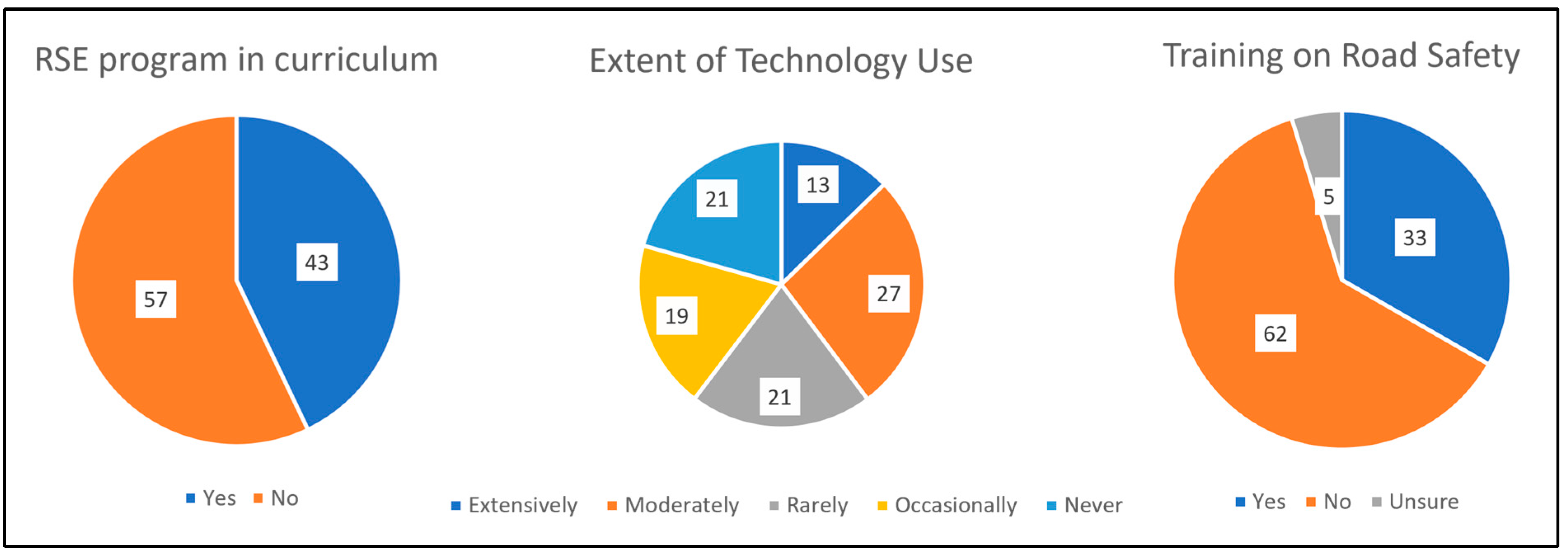
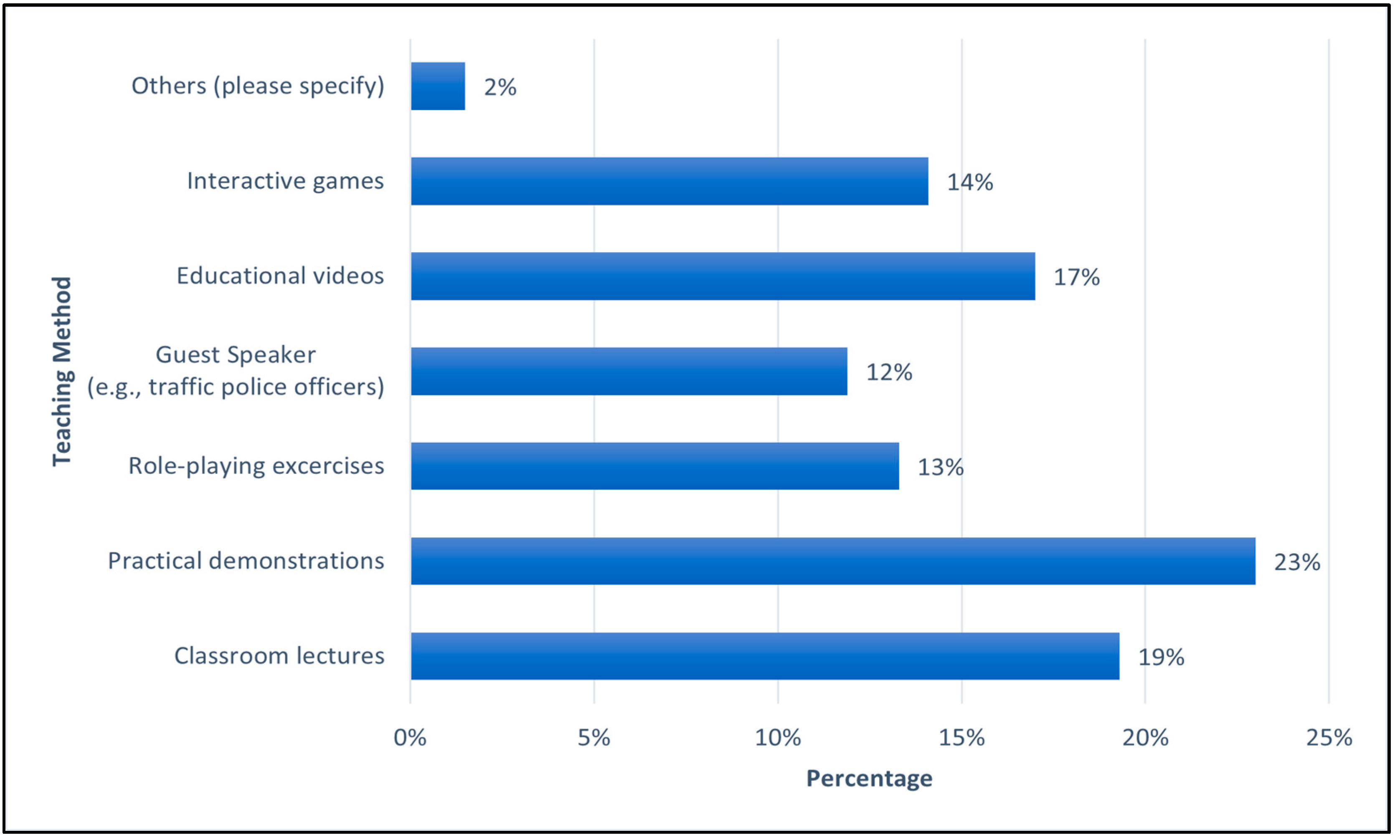
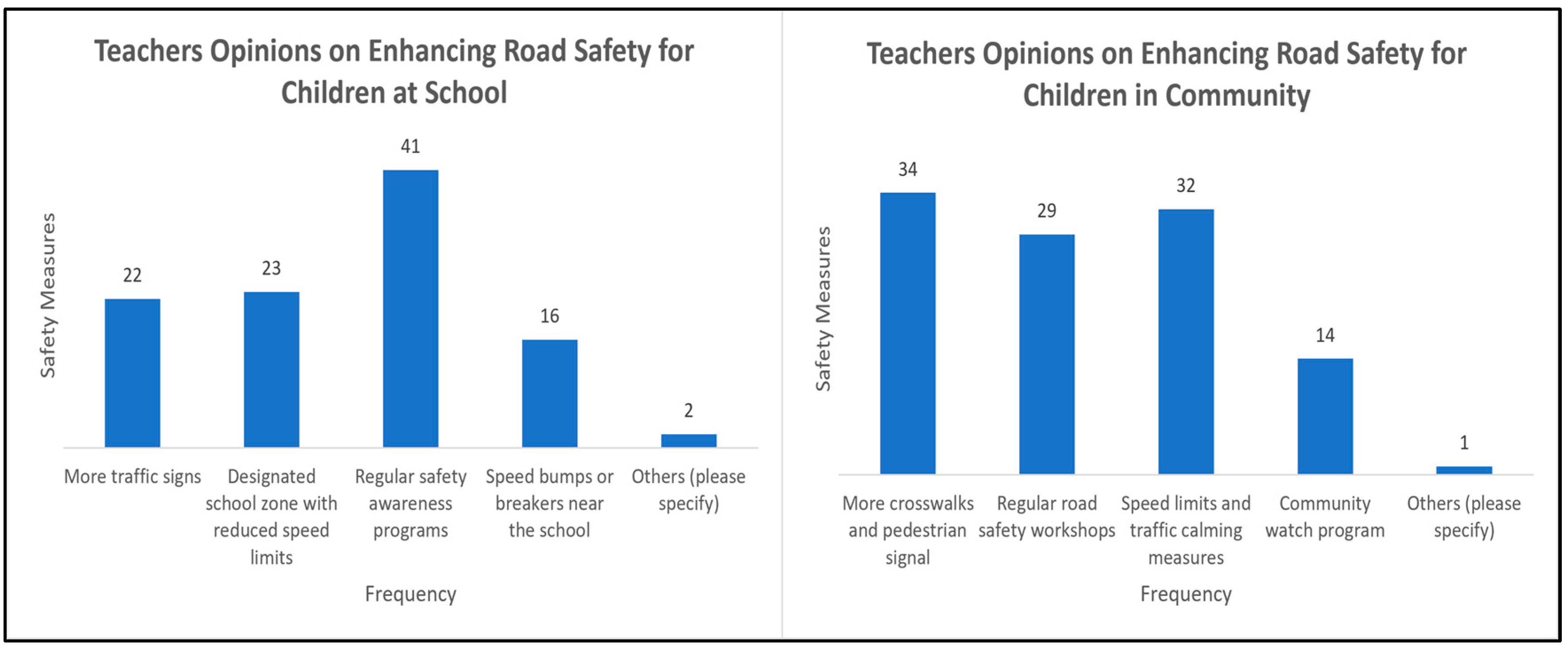

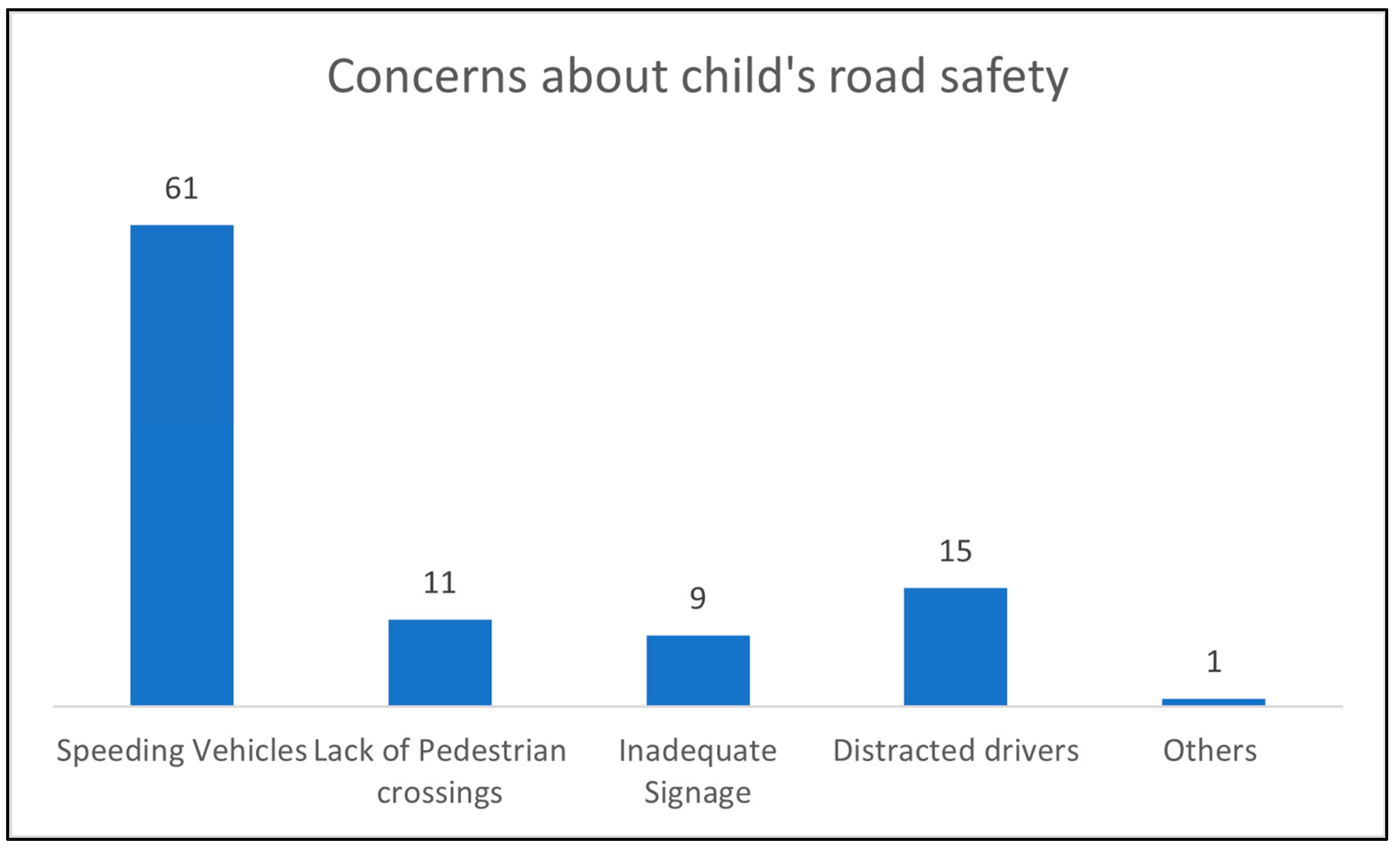
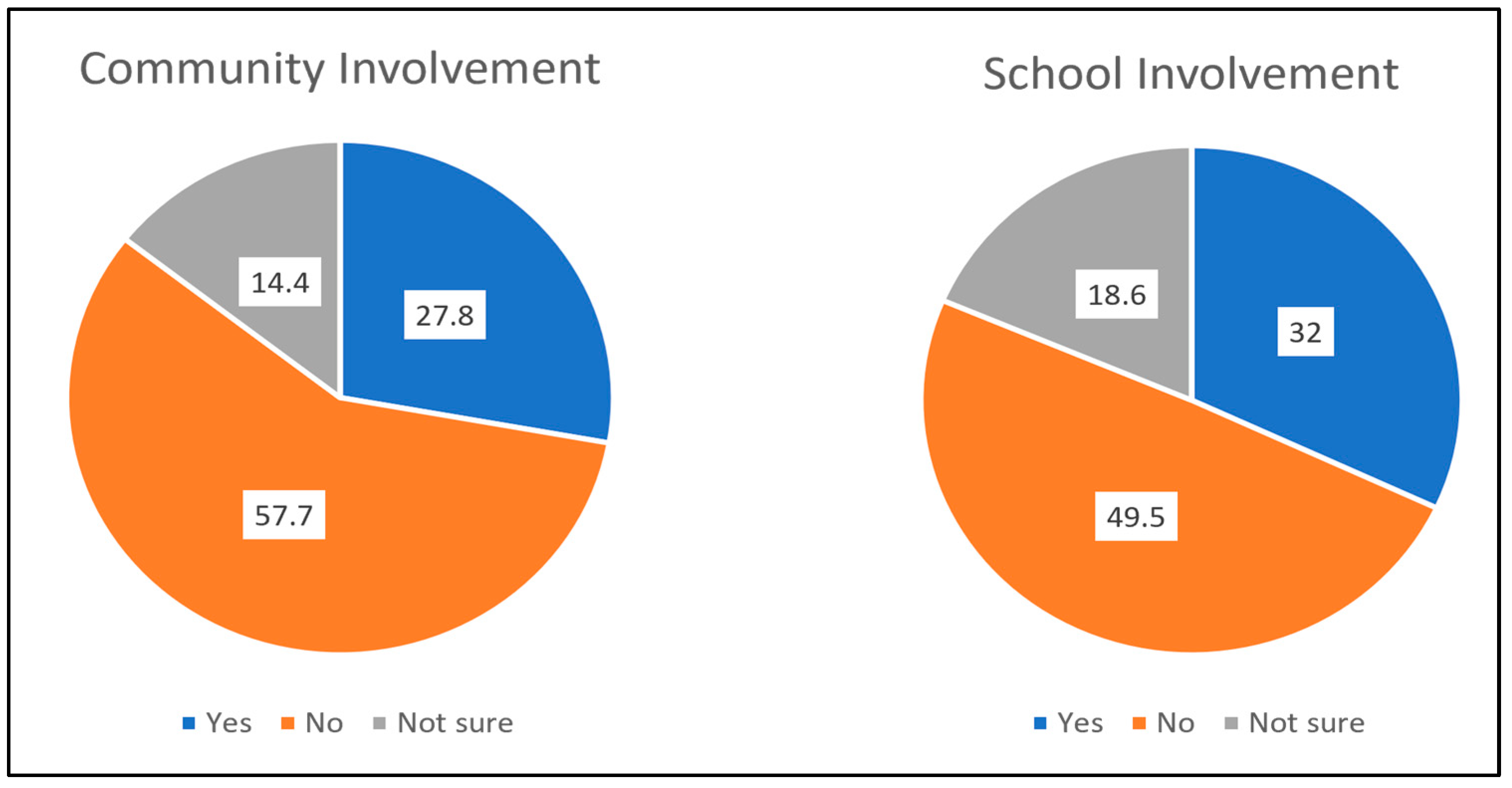
Disclaimer/Publisher’s Note: The statements, opinions and data contained in all publications are solely those of the individual author(s) and contributor(s) and not of MDPI and/or the editor(s). MDPI and/or the editor(s) disclaim responsibility for any injury to people or property resulting from any ideas, methods, instructions or products referred to in the content. |
© 2025 by the authors. Licensee MDPI, Basel, Switzerland. This article is an open access article distributed under the terms and conditions of the Creative Commons Attribution (CC BY) license (https://creativecommons.org/licenses/by/4.0/).
Share and Cite
Nawaz, I.; Cuenen, A.; Wets, G.; Janssens, D. Acceptability of Children Road Safety Education in Pakistan: A Mixed-Method Approach to Exploring Parents’ and Teachers’ Perspectives. Societies 2025, 15, 18. https://doi.org/10.3390/soc15010018
Nawaz I, Cuenen A, Wets G, Janssens D. Acceptability of Children Road Safety Education in Pakistan: A Mixed-Method Approach to Exploring Parents’ and Teachers’ Perspectives. Societies. 2025; 15(1):18. https://doi.org/10.3390/soc15010018
Chicago/Turabian StyleNawaz, Imran, Ariane Cuenen, Geert Wets, and Davy Janssens. 2025. "Acceptability of Children Road Safety Education in Pakistan: A Mixed-Method Approach to Exploring Parents’ and Teachers’ Perspectives" Societies 15, no. 1: 18. https://doi.org/10.3390/soc15010018
APA StyleNawaz, I., Cuenen, A., Wets, G., & Janssens, D. (2025). Acceptability of Children Road Safety Education in Pakistan: A Mixed-Method Approach to Exploring Parents’ and Teachers’ Perspectives. Societies, 15(1), 18. https://doi.org/10.3390/soc15010018







